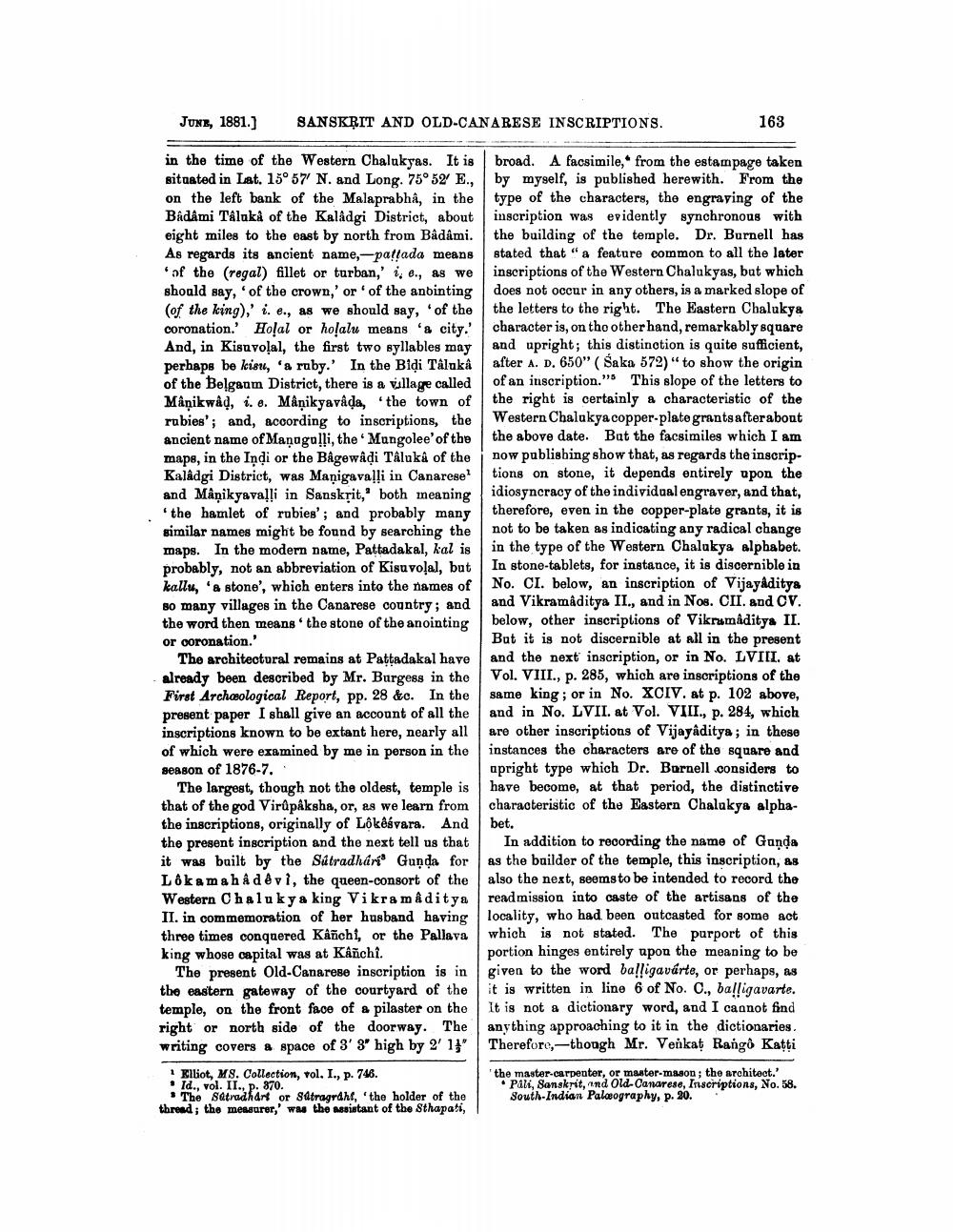________________
June, 1881.)
SANSKRIT AND OLD-CANARESE INSCRIPTIONS
163
in the time of the Western Chalukyas. It is broad. A facsimile, from the estampage taken situated in Lat. 15° 57' N. and Long. 75° 52' E., by myself, is published herewith. From the on the left bank of the Malaprabhâ, in the type of the characters, the engraying of the Badami Taluků of the Kalådgi District, about inscription was evidently synchronous with eight miles to the east by north from Bådámi. the building of the temple. Dr. Burnell has As regards its ancient name,-patada means stated that " a feature common to all the later
of the (regal) fillet or turban,' i, e., as we inscriptions of the Western Chalukyas, but which should say, 'of the crown,' or of the antinting does not occur in any others, is a marked slope of (of the king),' i. e., as we should say, "of the the letters to the right. The Eastern Chaluky& coronation.' Hoļal or holalu means '& city character is, on tho other hand, remarkably square And, in Kisu volal, the first two syllables may and upright; this distinction is quite sufficient, perhaps be kisu, 'a ruby. In the Biļi Tâlnkâ after A. D. 650" ( Saka 572)" to show the origin of the Belgaum District, there is a village called of an inscription." This slope of the letters to Måņikwad, i.e. Mánikyavada, the town of the right is certainly & characteristic of the rubies'; and, according to inscriptions, the Western Chalukyacopper-plategrants after about ancient name of Managalli, the Mongolee' of the the above date. Bat the facsimiles which I am maps, in the Indi or the Bâgewadi Taluka of the now publishing show that, as regards the inscripKalâdgi District, was Manigavalli in Canarese tions on stone, it depends entirely upon the and Mâņikyavaļli in Sanskrit,' both meaning idiosyncracy of the individual engraver, and that,
the hamlet of rubies'; and probably many therefore, even in the copper-plate grants, it is similar names might be found by searching the not to be taken as indicating any radical change maps. In the modern name, Pattadakal, kal is in the type of the Western Chalukya alphabet. probably, not an abbreviation of Kisuvoļal, but In stone-tablets, for instance, it is discernible in kallu, 'a stone', which enters into the names of No. Cl. below, an inscription of Vijayaditya BO many villages in the Canarese country, and
and Vikramaditya II., and in Nos. CII. and CV. the word then means the stone of the anointing below, other inscriptions of Vikramaditya II. or coronation.'
But it is not discernible at all in the present The architectural remains at Pattadakal have and the next inscription, or in No. LVIII. at already been described by Mr. Burgess in the Vol. VIII., p. 285, which are inscriptions of the First Archosological Report, pp. 28 &c. In the same king; or in No. XCIV. at p. 102 above, present paper I shall give an account of all the and in No. LVII. at Vol. VIII, p. 284, which inscriptions known to be extant here, nearly all are other inscriptions of Vijayaditya; in these of which were examined by me in person in the instances the characters are of the square and season of 1876-7.
apright type which Dr. Barnell.considers to The largest, though not the oldest, temple is have become, at that period, the distinctive that of the god Virupaksha, or, as we learn from characteristic of the Eastern Chalukya alphathe inscriptions, originally of Lôkêśvara. And bet. the present inscription and the next tell us that In addition to recording the name of Gunda it was built by the Sútradhári Gunda for as the builder of the temple, this inscription, as Lôkamah & devi, the queen-consort of the also the next, seems to be intended to record the Western Chalu kya king Vikramaditya readmission into caste of the artisans of the II. in commemoration of her husband having locality, who had been outcasted for some act three times conquered Káñchi, or the Pallava which is not stated. The purport of this king whose capital was at Kanchi.
portion hinges entirely upon the meaning to be The present Old-Canarese inscription is in given to the word balligavárte, or perhaps, as the eastern gateway of the courtyard of the it is written in line 6 of No. C., balligavarte. temple, on the front face of a pilaster on the It is not a dictionary word, and I cannot find right or north side of the doorway. The anything approaching to it in the dictionaries writing covers a space of 3' 3' high by 2' 13' Therefore, -thongh Mr. Venkat Rang) Katti Elliot, MS. Collection, vol. I., p. 746.
the master-carpenter, or master-mason; the architect.' • Id., vol. II, p. 870.
• Pari, Sanskrit, and Old-Canarese, Inscriptions, No. 58. • The sutradhdry or Satragrant, the holder of the South Indian Palæography, p. 20. thread; the measurer, was the assistant of the Sthapati,




